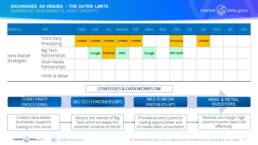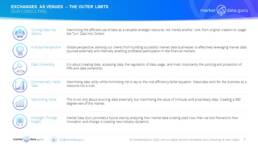

VENUES & THE FUTURE: OPPORTUNITIES & DEAD ENDS
What are exchange’s outer limits? Certainly continuing to expand the range of tradable instruments is well within any venue’s comfort zone, and will remain core to the business (Which MDG shall discuss in the next and final article).
Given the danger of trading product and domestic market information saturation the potential for wandering down strategic back alleys is high, and there are three that ought to be clearly signposted:
1.By nature exchanges are neither entrepreneurial, nor innovative. Risk is to be avoided. Trying to change to become something they are not will only end in a wreck. Fortunately, this is one dead end most are never likely to see
2.Re-inventing the wheel, exchanges are not resource rich. Developing new products and services for data beyond the provision of baseline raw data takes time, effort, and costs, only to replicate what is already available in the market. Exchanges like DBAG, ICE, LSEG and NASDAQ worked this out a long time ago. M&A brings experience, expertise, and most importantly clients with revenues
3.Adopting ‘Me too’ strategies. Something which happens all too often. What works for one exchange, does not necessarily translate to success for another, especially in the area of data pricing, policies and agreements. It is pretty to easy to spot exchanges which have copied and pasted from NASDAQ’s website
As MDG covered in our post ‘Breaking the Limits, Data, Analytics & Trade Workflow Solutions’ expanding the range of information service offerings offers the greatest opportunities to expand the business in new areas.
This is where the comfort zones becomes blurred. Within the data & analytics comfort zone exchanges are providing services to financial institutions, companies that pay top dollar because they make money out of turning information into revenue generating investment services. Given cost savings are top of the CFO’s to do lists right now, adding more data services is not a welcome topic for discussion.
This means re-purposing information services to engage with new markets, new types of lower margin clients, requiring alternative business models, which as our diagram below includes leveraging new partnerships to facilitate data processing, and reaching a new consumer base of retail clients using digital media.

THE FOUR OPPORTUNITIES
There are definitely more opportunities than the four which MDG highlights. However we shall focus on these for now:
1.Third Party Processing. Most exchanges already have in place the tech and systems to offer processing on behalf of their local clients. Smaller brokers and asset managers struggle to find the resources, and more importantly people, to manage key applications allowing them to trade on the exchange, especially risk, margin, & collateral management and post-trade processing. Exchanges have the capability to support their local investors through managing market data processing. This approach also begins to move them from content fodder to Big Tech partners. For more innovative exchanges there is potential to offer algorithmic trading models and other related services
2.Big Tech Partnerships. The largest Tier 1 exchanges are forging ahead with developing relationships which allow them to offer a greater range of services to clients who do not even use their own data. Many exchanges have established deals with Big Tech Clouds, but when one analyses these they are little more than storage and distribution. What Big Tech wants is to push the exchange’s clients to process their data in their Clouds where they can make their money. Without this any relationship an exchange has with any Cloud provider will prove little more than superficial. It requires a ‘quid pro quo’ that goes beyond mere content to a mutually beneficial (maybe not for the client) relationship where both parties expand their client base and reach
3.Multi-Media Partnerships. Exchanges do have relationships with digital media, but these extend little beyond providing data and usually at cheap rates for the amount of usage and access that happens downstream. Yet multi-media market data vendors have become remarkably sophisticated, companies like BarChart and TradingView allow trading straight from their graphs to brokers for execution to a venue. This is a growing marketplace where ancillary services are increasing in variety, further pushing out the limits of data usage
4.HNWI & Retail Markets. Many exchanges would argue they already customise their products and services to cater for these clients, but it is more of an afterthought. This end of the market is more complex with brokers offering a range of services from basic to full. The internet now provides insights and access that were never there previously for the investor on the street. It is a McDonalds v Moretons market where volume trumps margins and exchanges’ pricing and business models are not structured for this type of consumer.
While each opportunity can be developed individually, there are clear synergies between each of the options as part of the trade workflow. The first three are as applicable to catering for financial institutions as other types of clients. Each of these routes proffer the most immediate returns and are clearly based upon leveraging information, data and analytics.
SUMMARY
Exchanges and other venues must embrace the entire trading workflow even if they do not have the resources to be able to participate at every point. Specialisation becomes key for smaller exchanges and the ability to offer services which can in turn support their smaller clients enabling them to compete with the global investment bank juggernauts.
Most exchanges must face the fact they are not going to develop deep Big Tech LSEG/Microsoft or NASDAQ/AWS style relationships, so in order to avoid becoming content fodder they should, where they can, offer specialist information services to gain local advantages. Nobody in information services can be ‘All things to all men’.
Right now many exchanges are attracting regulatory interest because of the presumption data fees are too high, and that the exchanges rely far too heavily on raising prices either overtly or covertly as a primary means of revenue generation.
To avoid caps placing limits on price data revenues, exchanges have no choice but to add information products and services that will not be subject to regulatory fiat. This means firstly breaking their own limits before reaching for the outer limits in information services.
Perhaps the Royal Air Force’s motto should be an inspiration, ‘Per Ardua Ad Astra’
Talk to us about our consulting, and our independent advisory services
Keiren Harris 11 July 2023
For information on our consulting services please email Knharris@marketdata.guru
https://marketdata.guru/data-compliance
Please contact info@marketdata.guru for a pdf copy of the article
#exchanges #LSEG #NYSE #NASDAQ #equities #futures #derivatives #bonds #fx


